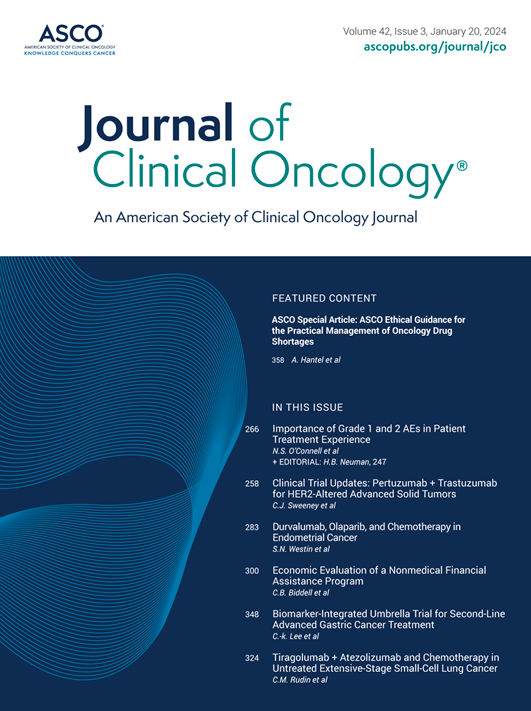Detecting early stage breast cancer using low-depth cell-free DNA fragmentomics: A multi-center cohort study.
IF 41.9
1区 医学
Q1 ONCOLOGY
引用次数: 0
Abstract
3075 Background: Breast cancer (BC) has contributed to the most cancer-related mortalities among females in 2020. Early detection using breast imaging methods, such as mammography and ultrasound, has significantly improved patients' survival. However, these early-screening methods suffer from high false-positive rates, resulting in many unnecessary biopsies which add to patients' discomfort. Cell-free DNA (cfDNA) fragmentomics assays have recently illustrated prominent abilities for detecting various cancer. In this multi-center prospective cohort study, we aim to develop a non-invasive liquid biopsy assay utilizing cfDNA fragmentomics and machine learning for detecting early-stage BC patients. Methods: We recruited 402 female patients (234 with BC and 168 with benign nodules [BN]) from the Yantai Yuhuangding Hospital (training cohort, N = 193, 91 BC and 102 BN) and the Cancer Hospital of the Chinese Academy of Medical Sciences (independent validation cohort, N = 209, 143 BC and 66 BN). Surgical or core needle biopsies were performed for all 402 patients following positive breast imaging results by mammography and ultrasound. Each patient's malignant or benign status was then pathologically confirmed using the tissue specimen. Women with negative biopsy results were excluded from breast cancer through a 6-month follow-up. The fragmentomics profiles, which were generated using plasma cfDNA WGS data (~5X), were used by our machine-learning algorithm. An automated machine learning approach was deployed to optimize base models before being ensembled into the final predictive model. Results: Our predictive model showed excellent performance in discriminating BCs from BNs, reaching an Area Under the Curve (AUC) of 0.816 and 0.811 in the training cohort (5-fold cross-validation) and the independent validation cohort, respectively. It achieved 74.1% sensitivity (95% CI: 66.1-81.1%) at 81.8% specificity (95% CI: 70.4-90.2%) in the validation cohort. In a potential clinical setting, our model could detect 53.0% (95% CI: 40.3-65.4%) false positives from the breast imaging methods at a targeted 90% sensitivity (89.5%, 95% CI:83.3–94.0%), which could theistically reduce more than half of the unnecessary biopsies. Moreover, our model illustrated great predictive power (AUC = 0.830) among small nodules (≤ 1cm), which were difficult to distinguish by the traditional imaging methods (AUC = 0.690). Finally, our model maintained its predictive power during a down-sampling process, even using 2X WGS data in the independent validation cohort (mean AUC: 0.789, 0.781-0.798). Conclusions: Our non-invasive liquid biopsy assay, which utilized low-depth cfDNA fragmentomics profiling and machine learning, can distinguish malignant nodules from benign nodules. The highlight of our model is its ability to prevent unnecessary biopsies among patients with false positive breast imaging results.使用低深度无细胞DNA片段组学检测早期乳腺癌:一项多中心队列研究。
3075背景:癌症(BC)是2020年女性癌症相关死亡人数最多的原因。使用乳腺成像方法(如乳房X光检查和超声波)进行早期检测,显著提高了患者的生存率。然而,这些早期筛查方法的假阳性率很高,导致许多不必要的活检,增加了患者的不适感。无细胞DNA(cfDNA)碎片组学分析最近显示了检测各种癌症的突出能力。在这项多中心前瞻性队列研究中,我们旨在开发一种利用cfDNA碎片组学和机器学习检测早期BC患者的非侵入性液体活检方法。方法:我们从烟台玉皇顶医院(训练队列,N=193,91BC和102BN)和中国医学科学院癌症医院(独立验证队列,N=209143BC和66BN)招募402名女性患者(234名BC和168名良性结节[BN])。在乳腺钼靶摄影和超声检查结果呈阳性后,对所有402名患者进行了手术或核心针活检。然后使用组织标本对每个患者的恶性或良性状态进行病理学确认。活组织检查结果为阴性的妇女通过6个月的随访被排除在癌症之外。我们的机器学习算法使用了使用血浆cfDNA WGS数据(~5X)生成的碎片组学图谱。在整合到最终预测模型中之前,部署了一种自动机器学习方法来优化基本模型。结果:我们的预测模型在区分BCs和BNs方面表现出优异的性能,在训练队列(5倍交叉验证)和独立验证队列中,曲线下面积(AUC)分别达到0.816和0.811。在验证队列中,它实现了74.1%的敏感性(95%可信区间:66.1-81.1%)和81.8%的特异性(95%置信区间:70.4-90.2%)。在潜在的临床环境中,我们的模型可以以目标90%的灵敏度(89.5%,95%CI:83.3-94.0%)检测到乳腺成像方法中53.0%(95%CI:403-65.4%)的假阳性,这可以极大地减少一半以上不必要的活检。此外,我们的模型在小结节(≤1cm)中显示出强大的预测能力(AUC=0.830),而传统的成像方法很难区分这些小结节(AUC=0.0690),即使在独立验证队列中使用2X WGS数据(平均AUC:0.789,0.781-0.798)。结论:我们的非侵入性液体活检分析利用低深度cfDNA碎片组学分析和机器学习,可以区分恶性结节和良性结节。我们的模型的亮点是它能够防止乳腺成像结果呈假阳性的患者进行不必要的活检。
本文章由计算机程序翻译,如有差异,请以英文原文为准。
求助全文
约1分钟内获得全文
求助全文
来源期刊

Journal of Clinical Oncology
医学-肿瘤学
CiteScore
41.20
自引率
2.20%
发文量
8215
审稿时长
2 months
期刊介绍:
The Journal of Clinical Oncology serves its readers as the single most credible, authoritative resource for disseminating significant clinical oncology research. In print and in electronic format, JCO strives to publish the highest quality articles dedicated to clinical research. Original Reports remain the focus of JCO, but this scientific communication is enhanced by appropriately selected Editorials, Commentaries, Reviews, and other work that relate to the care of patients with cancer.
 求助内容:
求助内容: 应助结果提醒方式:
应助结果提醒方式:


